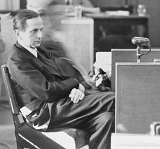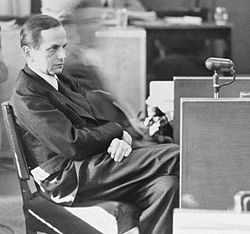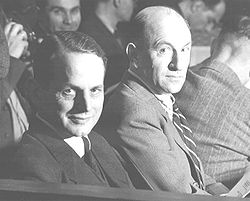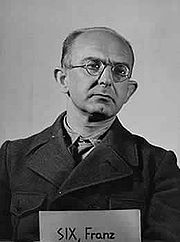
Einsatzgruppen Trial
Encyclopedia


War crime
War crimes are serious violations of the laws applicable in armed conflict giving rise to individual criminal responsibility...
s the U.S.
United States
The United States of America is a federal constitutional republic comprising fifty states and a federal district...
authorities held in their occupation zone in Germany
Germany
Germany , officially the Federal Republic of Germany , is a federal parliamentary republic in Europe. The country consists of 16 states while the capital and largest city is Berlin. Germany covers an area of 357,021 km2 and has a largely temperate seasonal climate...
in Nuremberg
Nuremberg
Nuremberg[p] is a city in the German state of Bavaria, in the administrative region of Middle Franconia. Situated on the Pegnitz river and the Rhine–Main–Danube Canal, it is located about north of Munich and is Franconia's largest city. The population is 505,664...
after the end of World War II
World War II
World War II, or the Second World War , was a global conflict lasting from 1939 to 1945, involving most of the world's nations—including all of the great powers—eventually forming two opposing military alliances: the Allies and the Axis...
. These twelve trials were all held before U.S. military courts, not before the International Military Tribunal, but took place in the same rooms at the Palace of Justice. The twelve U.S. trials are collectively known as the "Subsequent Nuremberg Trials
Subsequent Nuremberg Trials
The Subsequent Nuremberg Trials were a series of twelve U.S...
" or, more formally, as the "Trials of War Criminals before the Nuremberg Military Tribunals" (NMT).
The case
The EinsatzgruppenEinsatzgruppen
Einsatzgruppen were SS paramilitary death squads that were responsible for mass killings, typically by shooting, of Jews in particular, but also significant numbers of other population groups and political categories...
were SS
Schutzstaffel
The Schutzstaffel |Sig runes]]) was a major paramilitary organization under Adolf Hitler and the Nazi Party. Built upon the Nazi ideology, the SS under Heinrich Himmler's command was responsible for many of the crimes against humanity during World War II...
mobile death squad
Death squad
A death squad is an armed military, police, insurgent, or terrorist squad that conducts extrajudicial killings, assassinations, and forced disappearances of persons as part of a war, insurgency or terror campaign...
s, operating behind the front line in Nazi-occupied eastern Europe. From 1941 to 1943 alone, they murdered more than one million Jews and tens of thousands of "partisans", Roma, disabled persons, political commissars, and others. The 24 defendants in this trial were all officers of these Einsatzgruppen and faced mass murder
Mass murder
Mass murder is the act of murdering a large number of people , typically at the same time or over a relatively short period of time. According to the FBI, mass murder is defined as four or more murders occurring during a particular event with no cooling-off period between the murders...
charges. The tribunal stated in its judgment:
The judges in this case, heard before Military Tribunal II-A, were Michael A. Musmanno (presiding judge) from Pennsylvania
Pennsylvania
The Commonwealth of Pennsylvania is a U.S. state that is located in the Northeastern and Mid-Atlantic regions of the United States. The state borders Delaware and Maryland to the south, West Virginia to the southwest, Ohio to the west, New York and Ontario, Canada, to the north, and New Jersey to...
, John J. Speight from Alabama
Alabama
Alabama is a state located in the southeastern region of the United States. It is bordered by Tennessee to the north, Georgia to the east, Florida and the Gulf of Mexico to the south, and Mississippi to the west. Alabama ranks 30th in total land area and ranks second in the size of its inland...
, and Richard D. Dixon from North Carolina
North Carolina
North Carolina is a state located in the southeastern United States. The state borders South Carolina and Georgia to the south, Tennessee to the west and Virginia to the north. North Carolina contains 100 counties. Its capital is Raleigh, and its largest city is Charlotte...
. The Chief of Counsel for the Prosecution was Telford Taylor
Telford Taylor
Telford Taylor was an American lawyer best known for his role in the Counsel for the Prosecution at the Nuremberg Trials after World War II, his opposition to Senator Joseph McCarthy in the 1950s, and his outspoken criticism of U.S...
; the Chief Prosecutor for this case was Benjamin B. Ferencz
Benjamin B. Ferencz
Benjamin Berell' Ferencz is a Romanian-born American lawyer. He was an investigator of Nazi war crimes after World War II and the Chief Prosecutor for the United States Army at the Einsatzgruppen Trial, one of the twelve military trials held by the U.S. authorities at Nuremberg, Germany...
. The indictment
Indictment
An indictment , in the common-law legal system, is a formal accusation that a person has committed a crime. In jurisdictions that maintain the concept of felonies, the serious criminal offence is a felony; jurisdictions that lack the concept of felonies often use that of an indictable offence—an...
was filed initially on July 3 and then amended on July 29, 1947 to also include the defendants Steimle, Braune, Hänsch. Strauch, Klingelhöfer, and von Radetzky. The trial lasted from September 29, 1947 until April 10, 1948.
Indictment
- Crimes against humanity through persecutions on political, racial, and religious grounds, murder, extermination, imprisonment, and other inhumane acts committed against civilian populations, including German nationals and nationals of other countries, as part of an organized scheme of genocideGenocideGenocide is defined as "the deliberate and systematic destruction, in whole or in part, of an ethnic, racial, religious, or national group", though what constitutes enough of a "part" to qualify as genocide has been subject to much debate by legal scholars...
. - War crimes for the same reasons, and for wanton destruction and devastation not justified by military necessity.
- Membership in criminal organizations, the SSSchutzstaffelThe Schutzstaffel |Sig runes]]) was a major paramilitary organization under Adolf Hitler and the Nazi Party. Built upon the Nazi ideology, the SS under Heinrich Himmler's command was responsible for many of the crimes against humanity during World War II...
, the SDSicherheitsdienstSicherheitsdienst , full title Sicherheitsdienst des Reichsführers-SS, or SD, was the intelligence agency of the SS and the Nazi Party in Nazi Germany. The organization was the first Nazi Party intelligence organization to be established and was often considered a "sister organization" with the...
, or the GestapoGestapoThe Gestapo was the official secret police of Nazi Germany. Beginning on 20 April 1934, it was under the administration of the SS leader Heinrich Himmler in his position as Chief of German Police...
, which had been declared criminal organizations previously in the international Nuremberg Military Tribunals.
All defendants were charged on all counts. All defendants pleaded "not guilty". The tribunal found all of them guilty on all counts, except Rühl and Graf, who were found guilty only on count 3.
Defendants
| Name | Photo | Function | Sentence | Outcome, 1951 Amnesty |
|---|---|---|---|---|
| Otto Ohlendorf Otto Ohlendorf Otto Ohlendorf was a German SS-Gruppenführer and head of the Inland-SD , a section of the SD. Ohlendorf was the commanding officer of Einsatzgruppe D, which conducted mass murder in Moldova, south Ukraine, the Crimea, and, during 1942, the north Caucasus... |
 |
SS Gruppenführer Gruppenführer Gruppenführer was an early paramilitary rank of the Nazi Party, first created in 1925 as a senior rank of the SA.-SS rank:... ; member of the SD; commanding officer of Einsatzgruppe D |
Death by hanging | executed June 8, 1951 |
| Heinz Jost Heinz Jost Heinz Jost was an SS Brigadeführer and a Generalmajor of Police... |
 |
SS Brigadeführer Brigadeführer SS-Brigadeführer was an SS rank that was used in Nazi Germany between the years of 1932 and 1945. Brigadeführer was also an SA rank.... ; member of the SD; commanding officer of Einsatzgruppe A |
Lifetime imprisonment | commuted to 10 years; died 1964 |
| Erich Naumann Erich Naumann Erich Naumann was an SS-Brigadeführer, member of the SD. Naumann was responsible for genocide in eastern Europe as commander of Einsatzgruppe B and considered a war criminal.-Early life and career:... |
 |
SS Brigadeführer; member of the SD; commanding officer of Einsatzgruppe B | Death by hanging | executed June 8, 1951 |
| Otto Rasch Otto Rasch SS-Brigadeführer Otto Rasch was a high-ranking Nazi official in the occupied Eastern territories, commanding Einsatzgruppe C until October 1941. As a commanding officer, he was a Holocaust perpetrator and mass murderer.-Biography:Rasch was born in Friedrichsruh, northern Germany... |
 |
SS Brigadeführer; member of the SD and the Gestapo; commanding officer of Einsatzgruppe C | Removed from the trial on February 5 , 1948 due to medical reasons | died 1 November 1948 |
| Erwin Schulz (DE) |  |
SS Brigadeführer; member of the Gestapo; commanding officer of Einsatzkommando 5 of Einsatzgruppe C | 20 years | commuted to 15 years; released 9 January 1954-died 1981 |
| Franz Six Franz Six Dr. Franz Alfred Six was a Nazi official who rose to the rank of SS-Brigadeführer. He was appointed by Reinhard Heydrich to head department Amt VII, Written Records of the Reichssicherheitshauptamt... |
 |
SS Brigadeführer; member of the SD; commanding officer of Vorkommando Moscow of Einsatzgruppe B | 20 years | commuted to 15 years; released 30 September 1952-died 1975 |
| Paul Blobel Paul Blobel Paul Blobel was a German Nazi war criminal, an SS-Standartenführer and a member of the SD. Born in the city of Potsdam, he participated in the First World War, where by all accounts he served well and was decorated with the Iron Cross first class... |
 |
SS Standartenführer Standartenführer Standartenführer was a Nazi Party paramilitary rank that was used in the so-called Nazi combat-organisations: SA, SS, NSKK and the NSFK... ; member of the SD; commanding officer of Sonderkommando 4a of Einsatzgruppe C |
Death by hanging | executed June 8, 1951 |
| Walter Blume |  |
SS Standartenführer; member of the SD and the Gestapo; commanding officer of Sonderkommando 7a of Einsatzgruppe B | Death by hanging | commuted to 25 years; released 1955, died 1974 |
| Martin Sandberger Martin Sandberger Martin Sandberger was an SS Standartenführer and commander of Sonderkommando 1a of the Einsatzgruppe, as well as commander of the Sicherheitspolizei and SD in Estonia. He played an important role in the mass murder of the Jews in the Baltic states... |
 |
SS Standartenführer; member of the SD; commanding officer of Sonderkommando 1a of Einsatzgruppe A | Death by hanging | commuted to lifetime imprisonment, released in 1958, died 2010 |
| Willy Seibert (DE) |  |
SS Standartenführer; member of the SD; Deputy Chief of Einsatzgruppe D | Death by hanging | commuted to 15 years, died in 1976 |
| Eugen Steimle (DE) |  |
SS Standartenführer; member of the SD; commanding officer of Sonderkommando 7a of Einsatzgruppe B and of Sonderkommando 4a of Einsatzgruppe C | Death by hanging | commuted to 20 years; released June 1954; died 1987 |
| Ernst Biberstein Ernst Biberstein Ernst Emil Heinrich Biberstein was an SS-Obersturmbannführer , member of the SD and... |
 |
SS Obersturmbannführer Obersturmbannführer Obersturmbannführer was a paramilitary Nazi Party rank used by both the SA and the SS. It was created in May 1933 to fill the need for an additional field grade officer rank above Sturmbannführer as the SA expanded. It became an SS rank at the same time... ; member of the SD; commanding officer of Einsatzkommando 6 of Einsatzgruppe C |
Death by hanging | commuted to lifetime imprisonment, released in 1958, died 1986 |
| Werner Braune Werner Braune Karl Rudolf Werner Braune was a German member of the Nazi police and military organization known as the Schutzstaffel, or, more commonly, by its German initials, SS. He held the rank of Obersturmbannführer... |
 |
SS Obersturmbannführer Obersturmbannführer Obersturmbannführer was a paramilitary Nazi Party rank used by both the SA and the SS. It was created in May 1933 to fill the need for an additional field grade officer rank above Sturmbannführer as the SA expanded. It became an SS rank at the same time... ; member of the SD and the Gestapo;commanding officer of Sonderkommando 11b of Einsatzgruppe D |
Death by hanging | executed June 8, 1951 |
| Walter Haensch (DE) |  |
SS Obersturmbannführer; member of the SD; commanding officer of Sonderkommando 4b of Einsatzgruppe C | Death by hanging | commuted to 15 years |
| Gustave Nosske (DE) |  |
SS Obersturmbannführer; member of the Gestapo; commanding officer of Einsatzkommando 12 of Einsatzgruppe D | Lifetime imprisonment | commuted to 10 years; died 1990 |
| Adolf Ott (DE) |  |
SS Obersturmbannführer; member of the SD; commanding officer of Sonderkommando 7b of Einsatzgruppe B | Death by hanging | commuted to lifetime imprisonment; released 9 May 1958 |
| Eduard Strauch Eduard Strauch Eduard Strauch was an SS-Obersturmbannführer, commander of Einsatzkommando 2, commander of two Nazi organizations, the Security Police , or Sipo, and the Security Service , first in Belarus – then called White Russia or White Ruthenia – and later in Belgium... |
 |
SS Obersturmbannführer; member of the SD; commanding officer of Einsatzkommando 2 of Einsatzgruppe A | Death by hanging; handed over to Belgian Belgium Belgium , officially the Kingdom of Belgium, is a federal state in Western Europe. It is a founding member of the European Union and hosts the EU's headquarters, and those of several other major international organisations such as NATO.Belgium is also a member of, or affiliated to, many... authorities; died in hospital 11 September 1955. |
|
| Emil Haussmann Emil Haussmann Emil Haussmann served as an SS Sturmbannführer ; an officer in Einsatzkommando 12 of Einsatzgruppe D.One of 24 officers indicted during the Einsatzgruppen Trial, Haussmann committed suicide before the arraignment on July 31, 1947 - the only defendant who thus escaped being sentenced.... |
SS Sturmbannführer Sturmbannführer Sturmbannführer was a paramilitary rank of the Nazi Party equivalent to major, used both in the Sturmabteilung and the Schutzstaffel... ; member of the SD; officer of Einsatzkommando 12 of Einsatzgruppe D |
Committed suicide before the arraignment Arraignment Arraignment is a formal reading of a criminal complaint in the presence of the defendant to inform the defendant of the charges against him or her. In response to arraignment, the accused is expected to enter a plea... on July 31, 1947 |
||
| Waldemar Klingelhöfer Waldemar Klingelhöfer Waldemar Klingelhöfer ; died about 1980) was an SS-Sturmbannführer and convicted war criminal.-Early life:... |
 |
SS Sturmbannführer; member of the SD; officer of Sonderkommando 7b of Einsatzgruppe B | Death by hanging | commuted to lifetime imprisonment; released 1956-died 1980 |
| Lothar Fendler | SS Sturmbannführer; member of the SD; Deputy chief of Sonderkommando 4b of Einsatzgruppe C | 10 years; reduced to 8 years | commuted to 8 years | |
| Waldemar von Radetzky (DE) |  |
SS Sturmbannführer; member of the SD; Deputy chief of Sonderkommando 4a of Einsatzgruppe C | 20 years | released |
| Felix Rühl | SS Hauptsturmführer Hauptsturmführer Hauptsturmführer was a Nazi rank of the SS which was used between the years of 1934 and 1945. The rank of Hauptsturmführer was a mid-grade company level officer and was the equivalent of a Captain in the German Army and also the equivalent of captain in foreign armies... ; member of the Gestapo; officer of Sonderkommando 10b of Einsatzgruppe D |
10 years | released | |
| Heinz Schubert (DE) |  |
SS Obersturmführer Obersturmführer Obersturmführer was a paramilitary rank of the Nazi party that was used by the SS and also as a rank of the SA. Translated as “Senior Assault Leader”, the rank of Obersturmführer was first created in 1932 as the result of an expansion of the Sturmabteilung and the need for an additional rank in... ; member of the SD; officer in Einsatzgruppe D |
Death by hanging | commuted to 10 years |
| Mathias Graf | SS Untersturmführer Untersturmführer Untersturmführer was a paramilitary rank of the German Schutzstaffel first created in July 1934. The rank can trace its origins to the older SA rank of Sturmführer which had existed since the founding of the SA in 1921... ; member of the SD; officer in Einsatzkommando 6 of Einsatzgruppe D |
Time already served |
Rasch had to be removed from the courtroom during the arraignment due to his poor health; he was arraigned separately on September 22, 1947.
Strauch suffered an epileptic attack
Epilepsy
Epilepsy is a common chronic neurological disorder characterized by seizures. These seizures are transient signs and/or symptoms of abnormal, excessive or hypersynchronous neuronal activity in the brain.About 50 million people worldwide have epilepsy, and nearly two out of every three new cases...
during the arraignment on September 15, 1947. His defense later tried to get him removed from the trial on medical grounds, but the tribunal dismissed this, stating that Strauch's testimonies (which he did give subsequently) were coherent and showed no reason why he shouldn't be mentally capable to stand trial.
While Fendler was found guilty on all counts, the tribunal considered the evidence presented insufficient to prove that he ordered or helped plan the killings. He seems to have held primarily an office post.
Rühl was found guilty only on count 3; regarding counts 1 and 2, the tribunal found him not guilty, stating that as a subaltern officer, he was not responsible for the atrocities committed by Einsatzgruppe D and in no position to prevent them, and although he knew of the killings, it could not be proved that he directly participated in them.
Graf was found guilty only of membership in the SD. He had actually been expelled from the SS for "general indifference to the organization" and later had tried to be relieved from the SD. On counts 1 and 2, he was also found not guilty, because as a noncommissioned officer, he had never held any command post, and in fact even refused one once.
Of the 14 death sentences, only four were carried out; the others were commuted to prison terms of varying lengths in 1951. In 1958, all convicts were released from prison.
Quotes
From the tribunal's judgment:See also
- Benjamin B. FerenczBenjamin B. FerenczBenjamin Berell' Ferencz is a Romanian-born American lawyer. He was an investigator of Nazi war crimes after World War II and the Chief Prosecutor for the United States Army at the Einsatzgruppen Trial, one of the twelve military trials held by the U.S. authorities at Nuremberg, Germany...
- Commissar OrderCommissar OrderThe Commissar Order was a written order given by Adolf Hitler on 6 June 1941, prior to Operation Barbarossa. Its official name was Guidelines for the Treatment of Political Commissars...
, an order stating that Soviet political commissars were to be shot on the battlefield.
Further reading
- Ferencz, BenjaminBenjamin B. FerenczBenjamin Berell' Ferencz is a Romanian-born American lawyer. He was an investigator of Nazi war crimes after World War II and the Chief Prosecutor for the United States Army at the Einsatzgruppen Trial, one of the twelve military trials held by the U.S. authorities at Nuremberg, Germany...
, “A Prosecutor's Personal Account: From Nuremberg to
Rome", 52 Journal of International Affairs, No. 2, Columbia University, Spring, 1999,
External links
- Description from the U.S. Holocaust Memorial Museum.
- Another description.

